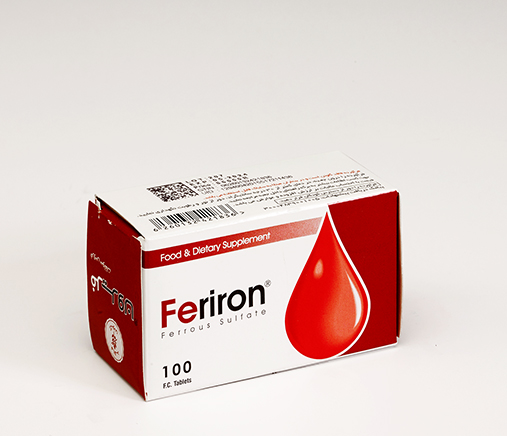Ferrous Sulfate
- Ferrous Sulfate
- Feriron®
- Tablet
- 50mg
- Blister
- 100 Tablets
-
• Iron Deficiency Anemia
Mechanism of Action
Feriron® replaces iron stores found in hemoglobin, myoglobin, and enzymes, allows transportation of oxygen via hemoglobin
Pharmacokinetics
Bioavailability: 5-10% (20-30% during deficiency)
Onset: Reticulocytosis, 3-10 days; increased hemoglobin values, 2-4 wk
Excretion: Sweat, urine, menses, sloughed intestinal mucosa
Contraindications
• Hypersensitivity
• Hemochromatosis, hemolytic anemia
Adverse Reactions
Constipation, Contact irritation, Diarrhea, Dark stools, GI irritation, Nausea, Stomach pain, Superficial, Urine discoloration, Vomiting
Major Drug Interactions
-
Warnings
• Avoid use in peptic ulcer disease, ulcerative colitis, regional enteritis, and patients receiving frequent blood transfusions
• Avoid use in premature infants until vitamin E stores, which are deficient at birth are replenished
• Avoid administering iron for >6 months except in patients with continuous bleeding or menorrhagia
Recommendations for Patient
• Accidental overdose of iron-containing products is a leading cause of fatal poisoning in children younger than 6 years. Keep this product out of reach of children. If overdose does occur, get medical help right away or call a poison control center.
Pregnancy Considerations
Category: Not studied
Breastfeeding Considerations
Drug is excreted in breast milk
Pregnancy Categories
A: Generally acceptable. Controlled studies in pregnant women show no evidence of fetal risk.
B: Maybe acceptable. Either animal studies show no risk but human studies not available or animal studies showed minor risks and human studies done and showed no risk.
C: Use with caution if benefits outweigh risks. Animal studies show risk and human studies not available or neither animal nor human studies done.
D: Use in LIFE-THREATENING emergencies when no safer drug available. Positive evidence of human fetal risk.
X: Do not use in pregnancy. Risks involved outweigh potential benefits. Safer alternatives exist.
NA: Information not available.

Feriron® replaces iron stores found in hemoglobin, myoglobin, and enzymes, allows transportation of oxygen via hemoglobin
Pharmacokinetics
Bioavailability: 5-10% (20-30% during deficiency)
Onset: Reticulocytosis, 3-10 days; increased hemoglobin values, 2-4 wk
Excretion: Sweat, urine, menses, sloughed intestinal mucosa
Contraindications
• Hypersensitivity
• Hemochromatosis, hemolytic anemia
Adverse Reactions
Constipation, Contact irritation, Diarrhea, Dark stools, GI irritation, Nausea, Stomach pain, Superficial, Urine discoloration, Vomiting
Major Drug Interactions
-
Warnings
• Avoid use in peptic ulcer disease, ulcerative colitis, regional enteritis, and patients receiving frequent blood transfusions
• Avoid use in premature infants until vitamin E stores, which are deficient at birth are replenished
• Avoid administering iron for >6 months except in patients with continuous bleeding or menorrhagia
Recommendations for Patient
• Accidental overdose of iron-containing products is a leading cause of fatal poisoning in children younger than 6 years. Keep this product out of reach of children. If overdose does occur, get medical help right away or call a poison control center.
Pregnancy Considerations
Category: Not studied
Breastfeeding Considerations
Drug is excreted in breast milk
Pregnancy Categories
A: Generally acceptable. Controlled studies in pregnant women show no evidence of fetal risk.
B: Maybe acceptable. Either animal studies show no risk but human studies not available or animal studies showed minor risks and human studies done and showed no risk.
C: Use with caution if benefits outweigh risks. Animal studies show risk and human studies not available or neither animal nor human studies done.
D: Use in LIFE-THREATENING emergencies when no safer drug available. Positive evidence of human fetal risk.
X: Do not use in pregnancy. Risks involved outweigh potential benefits. Safer alternatives exist.
NA: Information not available.
Send to other people



